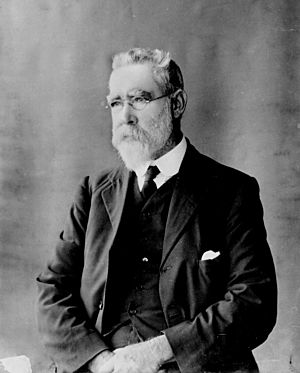Thomas Lane Bancroft facts for kids
Thomas Lane Bancroft (1860–1933) was an Australian scientist and doctor. He lived in Queensland and is famous for his important research. He studied diseases spread by mosquitoes, like filariasis. He also researched the amazing Australian lungfish and worked on creating new kinds of crops.
Contents
Early Life and Discoveries
Thomas Lane Bancroft was born in England on January 2, 1860. When he was four, he moved to Queensland with his parents. He went to school in Brisbane and then studied medicine in Scotland at the University of Edinburgh.
After becoming a doctor, he came back to Brisbane. Like his father, he loved natural science. He spent a lot of his time and money studying nature. In Brisbane, he helped his father at Deception Bay. There, they grew many different crops. They even created new types of wheat, rice, grapes, and strawberries by cross-breeding them.
Studying Mosquitoes and Diseases
Thomas Bancroft also did a lot of his own research. After his father passed away in 1894, Thomas continued his father's work on filaria. This is a tiny worm that causes a disease called filariasis.
Bancroft raised common house mosquitoes (called Culex fatigans). He let these mosquitoes bite a person who had filaria. He then showed that the tiny worms lived and grew inside the mosquitoes. At first, people didn't know how the disease spread from mosquitoes to humans. Bancroft first thought it might be from eating contaminated food. But then he realized that the worms would probably die in the stomach. So, he suggested that the disease spread when a mosquito bit someone. We now know he was right!
He also noticed that the mosquitoes that spread filaria only lived around houses. He said that people could control them by putting up screens on windows or by regularly emptying any water containers near their homes. These ideas are now used and required in Queensland. He also suggested cleaning and deepening water reservoirs. He wanted the areas around them fenced off and planted with grass to keep the water clean.
Bancroft also did other research. He tested cures for snakebites. He looked into a skin disease called mange that affected horses. He also studied how to make eucalyptus oil from native eucalyptus trees.
Cotton and the Lungfish Life Cycle
Bancroft became a doctor in Eidsvold. People there knew him for being very kind and generous.
Growing New Crops
In Eidsvold, he grew many types of cotton, including special "Sea Island" cotton. He did a lot of work to breed new kinds of cotton. Sadly, many of his findings were lost because he was a humble person and didn't promote his work much. He was also very interested in castor oil plants. He created several new types of these plants. However, there wasn't much demand for castor oil at the time, so this work wasn't immediately useful locally.
Studying the Australian Lungfish Life Cycle
Because he lived near the Burnett River, Bancroft became interested in fish. He was especially fascinated by the unique Australian lungfish, also known as Ceratodus. This fish is often called a "living fossil" because it's very old and hasn't changed much over millions of years.
Bancroft studied its life cycle very closely. He was very clever in setting up ways to breed and watch the fish in special tanks. He noticed that fewer and fewer of these special fish were left. So, he suggested protecting them. He even proposed creating a breeding station for them on Stradbroke Island. While that station wasn't built, lungfish were later introduced into the Logan River and other rivers in Queensland to help their numbers grow.
Palm Island Work
In late 1930, Bancroft became a doctor at the Palm Island Aboriginal Settlement. He hoped to spend his later years there comfortably. He wanted to have time to experiment with cotton and lungfish. Unfortunately, during his journey, he lost most of the young fish he was bringing with him. This meant he couldn't continue his lungfish research there.
When he finally arrived on the island, he was disappointed. He had expected a tropical island with lots of plants. Instead, he found a rocky island mostly covered with blady grass, with only a few trees in the valleys. There wasn't much fishing or hunting, and very few insects or birds. The only farm area was a reclaimed swamp, which was needed to grow food for the Aboriginal people living there.
Even though the heat and humidity made him sick, and there wasn't enough water for farming, he tried to grow his cotton varieties. He had brought cuttings of them from Eidsvold. He also wondered if the blady grass on the island could be used to make paper.
Bancroft strongly believed it was his job to make life better for the Aboriginal people. He worked hard to use all the available land to grow food. He disagreed with the policy of growing Mauritius beans to sell to farmers on the mainland, especially when the Aboriginal people on the island needed more food themselves.
Later Years and Legacy
In May 1932, he left Palm Island and moved to Wallaville near Bundaberg. He planned to semi-retire, looking forward to having more freedom and time for a small private medical practice and continuing his research.
Thomas Lane Bancroft passed away on November 12, 1933, at his home in Wallaville. He was 73 years old. He was buried at Toowong Cemetery in Brisbane.
Lasting Impact
Bancroft loved collecting plant samples to have them officially named and described. Because of his efforts, several plants are named after him, including Elaeocarpus bancroftii, Viscum bancroftii, Beilschmiedia bancroftii, and Stephania bancroftii.
There is a monument dedicated to Thomas Bancroft and his father, Joseph Bancroft. It is located in Bancroft Park at Deception Bay. This monument was unveiled in 1963 to honor their important scientific work in Queensland.
Images for kids



